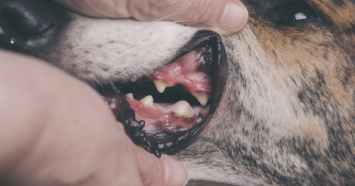
Dental radiographs are a key aspect of a pet’s teeth cleaning experience. Once, a newly adopted Cocker Spaniel was brought to me for suspected dental problems. She was a finicky eater, dropped food while eating, and drooled more than her new parents had ever witnessed in a dog. Her parents thought she may also eat out of only one side of her mouth, but they couldn’t be sure.
I proceeded with dental X-rays and a dental cleaning. I expected to find teeth that needed to be extracted, but what I saw is the strangest thing I have ever seen in my life: a CLOTHESPIN was embedded within her jaw and completely covered by oral tissue.
We removed the clothespin and part of her jaw, and after a far less extensive recovery than you would expect, she bounced back with a new zest for life. While this is not a common finding of dental X-rays, you might be surprised at what veterinarians do commonly see – which is why dental X-rays for dogs are so important.
What Dog Dental X-rays Can Show
Periodontal disease is the most common disease (not just dental disease) in dogs and cats. Cleaning the visible tooth and just below the gum line isn’t enough for many pets. The real disease may lie deeper, where we can’t actually see.
When you look at an X-ray of a dog’s mouth, more than half of the tooth is hidden by gum tissue and dental tartar. Without radiographs, veterinarians would miss about 80% of the problems in our patient’s mouths.
Radiography commonly reveals:
Deep infections
Abscesses
Cysts
Resorption teeth roots
Tooth roots left behind after incomplete extraction or fracture
Dead teeth
& more
Research published in the American Journal of Veterinary Research estimates that greater than 25% of dogs and 40% of cats have significant oral disease that is not visible. These statistics explain why dental radiographs are such an important part of dental cleanings, routine or otherwise.
When to Consider Dental X-rays for Dogs
Some of the symptoms that could signal that your pet has a dental problem include:
Discolored teeth
Gum redness or inflammation
Blood-tinged saliva
Excessive salivation
Dropping food
Visible tooth fractures
Trouble chewing
Missing teeth
Swellings & masses in the oral cavity
Decreased appetite
Watch for signs and let your veterinarian know if you suspect anything abnormal in your pet’s mouth.
Early screening with radiography is key to preventing oral pain and disease in your pets. Familiarize yourself with the signs that your pet may have dental disease and follow your gut. Regular checkups by your veterinarian will spot dental problems early (hopefully of the more common variety than misplaced clothespins) and keep your pet’s mouth free of discomfort or illness.